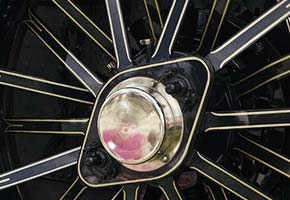Available Technologies
# of Displayed Technologies: 9 / 9
Applied Category Filter (Click To Remove): Welding/Joining
Apparatus and Method for Enhanced Determination of Optimal Operational Separation for Collaborative Robotic Systems
TS-063983 —
Collaborative robotic systems, often referred to as cobots, represent a transformative advancement in industrial automation. Unlike traditional robots that are typically large, heavy, and designed to work in insolation behind safety barriers, cobots are designed to work alongside human operators c…
- College: College of Food, Agricultural, and Environmental Sciences (CFAES)
- Inventors: Tkach, Chris
- Licensing Officer: Zinn, Ryan
Integrally Joined Stainless Steel-NiTi Medical Devices
TS-050057 — A method for manufacturing surgical tools and implants with strong, gapless joints between NiTi (Nitinol) and stainless steel to capitalize on the best properties of both materials.
NiTi (Nitinol) is widely accepted and used for medical devices such as surgical tools and implants due to its biocompatibility and unique thermal-mechanical properties which provide super-elastic or shape memory responses. However, there are currently no commercial solutions for joining of NiTi to…
- College: College of Engineering (COE)
- Inventors: Panton, Boyd; Dapino, Marcelo; Gingerich, Mark; Headings, Leon; Morris, Jennifer
- Licensing Officer: Zinn, Ryan
Integration of smart materials into surgical tools and medical devices using vaporizing foil actuator technology.
TS-045092 —
Shape memory alloys are metals that "remember" their original shape when deformed and can return to their initial shape when heated. These shape memory alloys cannot currently be welded to other alloys, which significantly limits their use. Current state-of-the-art methods of joining sha…
- College: College of Engineering (COE)
- Inventors: Panton, Boyd; Daehn, Glenn; Vivek, Anupam
- Licensing Officer: Zinn, Ryan
Ultrasonic Resistance Spot Welding Process and Apparatus
TS-041781 — An improvement to ultrasonic and resistance spot welding
Ultrasonic welding is widely used in the electronics industry to weld together wiring in delicate circuits and on microcircuits. It is also used in the automotive industry, medical industry, and packaging industry, often to weld dissimilar materials or plastics. The major advantages in ultrasonic …
- College: College of Engineering (COE)
- Inventors: Liu, Xun; Benatar, Avraham "Avi"; Kimchi, Menachem
- Licensing Officer: Zinn, Ryan
Hybrid Structures for Joining of Metals and Continuous Fiber Materials
TS-037339 — Emerging technology that uses solid state ultrasonic metal welding to create metal parts.
Various market segments such as automotive and aerospace continue to seek more ways to 'lightweight' their vehicles using more aluminum, magnesium, titanium and other low-weight alloys in place of heavier alloys. This also includes composites. To incorporate these lightweighting materials …
- College: College of Engineering (COE)
- Inventors: Dapino, Marcelo; Detwiler, Duane; Gingerich, Mark; Hahnlen, Ryan; Headings, Leon; Scheidt, Matthew; Sheldon, Allen
- Licensing Officer: Zinn, Ryan
Gas Chromotography TCD Hydrogen Calibration Valve
TS-036946 — An in-line valve designed specifically to direct the flow of gasses within a gas chromotography machine.
Current metallurgy research requires a hydrogen measurement device to quantify the amount of hydrogen in a weld and the diffusion rate of hydrogen after failure to analyze the effects hydrogen assisted cracking. With this information, research groups can evaluate the performance of various welds a…
- College: College of Engineering (COE)
- Inventors: Wildofsky, Jacob; Alexandrov, Boian; Copley, Kenneth
- Licensing Officer: Zinn, Ryan
U+RSW - A Break-Through Process for Dissimilar Metal Joining in Automotive Industries
TS-036907 — A welding technique that joins two dissimilar metals.
Resistance spot welding (RSW) is critical to automobile manufacturing, with 3,000 to 5,000 spot welds per vehicle. As consumers seek vehicles with better fuel economy, automobile manufacturers have replaced parts built from heavy metals, such as advanced high-strength steel (AHSS), with lighter al…
- College: College of Engineering (COE)
- Inventors: Zhang, Wei; Kimchi, Menachem; Lu, Ying "ying"; Mayton, Ellis
- Licensing Officer: Zinn, Ryan
 Method and Device to Monitor & Control Efficiency of the Friction Welding Process
Method and Device to Monitor & Control Efficiency of the Friction Welding Process
TS-015293 — A device that can be readily attached to inertia or direct drive friction welding equipment to determine energy efficiency in-situ during welding, providing real-time feedback for improving control.
Friction welding is a category of solid-state welding processes that uses frictional heat generation at the weld interface to plasticize the work pieces and produce a metallurgical bond. The welding parameters used in large-scale industrial production are typically determined via trial and error. …
- College: College of Engineering (COE)
- Inventors: Zhang, Wei; Mahaffey, David; Semiatin, Sheldon; Senkov, Oleg; Tung, Daniel
- Licensing Officer: Zinn, Ryan
Device and Technique for Investigation of Phase Transformations in Metals and Alloys Using The Single Sensor Differential Thermal Analyzer (SS-DTA)
TS-015281 —
Dilatometry is a technique currently used for measuring thermal expansion and dilation in solids and liquids. NETZSCH currently offers a variety of dilatometers. However, this equipment can cost thousands of dollars. There is always room for improvement for a faster, simpler, and less expensive te…
- College: College of Engineering (COE)
- Inventors: Alexandrov, Boian; Lippold, John
- Licensing Officer: Zinn, Ryan
